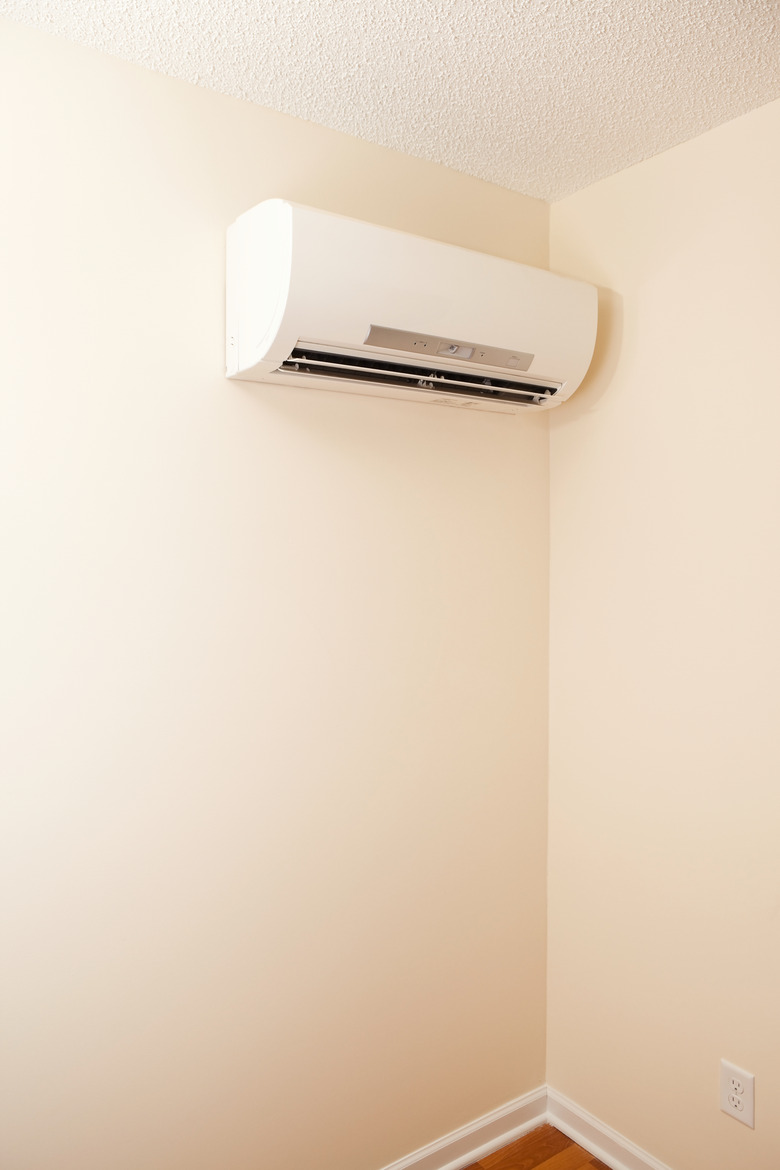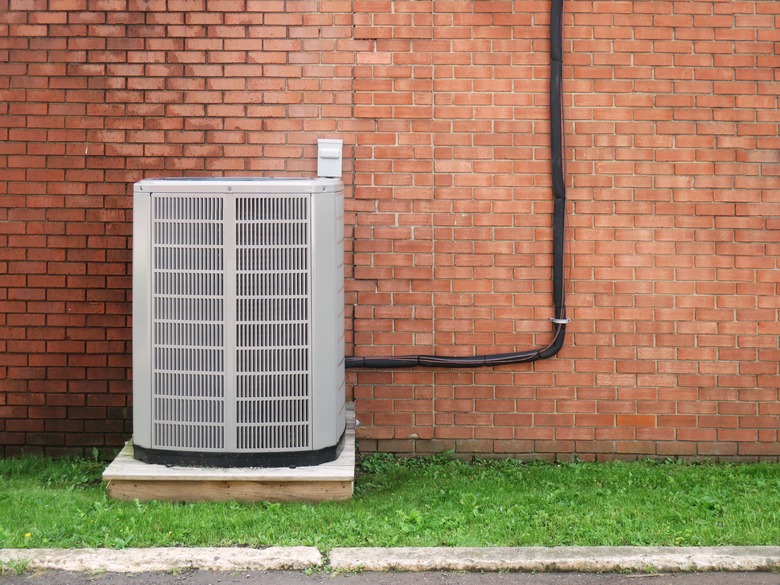Minisplit Vs. Central Air: Which Is Best When Choosing A New Air Conditioner?
We may receive a commission on purchases made from links.
If your house doesn't already have air conditioning, you may be literally feeling that it's time to install it now considering the longer, more frequent and more severe heat waves in North America. Not too long ago, your choices would have been limited to a central air conditioning system or one or more wall- or window-mount units, but now you also have an option that has been popular in Japan and the rest of Asia for 30 years or more: ductless minisplit air conditioners. Wall- and window-mount units are great short-term solutions because they are inexpensive and easy to install, but when it comes to permanent fixtures, central AC units and ductless minisplit systems are more realistic options for several reasons.
Rather than stay in suspense about which one you should choose, it should be said up front that a ductless minisplit system is a cut above a central AC system, especially if your home doesn't already have ductwork. Minisplits cost more to install if your home has ductwork, but if it doesn't, the cost to install the ducts can exceed the cost of the AC unit itself, and that makes minisplits the obvious choice. Even if your home does have ductwork, a minisplit system is probably still a more advantageous choice because it offers more functionality, higher energy efficiency and more flexibility.
These perks don't make the decision a slam dunk because whole-house air conditioners do offer some of their own benefits. One of the most important is better filtration, which is important if you're concerned about air quality. Besides having a better filtration system, a central AC unit can work in conjunction with an air exchanger, a dehumidifier or a humidifier, making it better suited for well-rounded interior climate control. That's important if you live in the West, where air is dry and smoke from wildfires is a yearly hazard; in the South, where humidity is a constant problem; or in a crowded city anywhere that has heavy air pollution.
Tip
Ductless minisplits and central air conditioning units work basically the same way, but minisplits offer more flexibility and energy savings and are definitely a more economical choice for homes without existing ductwork.
Split-System Air Conditioning Units
Split-System Air Conditioning Units
Both a central air conditioning system and a ductless minisplit air conditioner are split systems consisting of an outdoor unit and an indoor unit connected by a tube that contains the refrigeration pipes and control wiring. The outdoor unit houses the compressor and condenser coil, while the evaporator coil that provides the cooling is in the indoor unit. The difference between them is that the coil in a whole-house AC unit is inside a central air handler with a blower that circulates the conditioned air throughout the home's air ducts, while a minisplit coil is inside a wall-mounted unit that has its own blower that can service a single room at most.
Both systems work on the same principle as any air conditioning unit. The compressor pressurizes refrigerant in the condenser coils to turn it into a liquid, which is a process that releases heat, and the liquefied refrigerant is pumped toward a tiny aperture that allows only a small amount to pass into the evaporator coil. The sudden pressure drop causes it to vaporize, which is a process that draws heat out of the air, and a blower circulates the cool air throughout a room or the entire house. The refrigerant returns to the compressor, where it is pressurized back into a liquid to begin the cycle again.
This cycle can be reversed by changing the direction of the refrigerant, making the outdoor coil cool and the indoor coil hot, which turns the air conditioning unit into a heat pump. You may not need this extra functionality if you have an existing heating system, but if you don't, a heat pump is a convenient feature, and it can also supplement your existing heating system and save energy costs. Heat pumps have traditionally been recommended only for mild climates, but due to a number of recent technological advances, modern ones can heat your house even in extreme cold.
Ductless Air Conditioning Pros and Cons
Ductless Air Conditioning Pros and Cons
Although it's obvious, it's worth repeating that ductless minisplit systems don't need ducts, so if your home is on a slab foundation, lacks a crawl space or attic or is otherwise unsuitable for a ductwork system, a ductless system is the logical choice. You do need to punch a hole in the wall to install the tubing between the indoor and outdoor units, but it's a relatively small one that's easy to seal. Some of the benefits a ductless system offers are:
- High efficiency: Ductless air conditioning consumes 30 percent less energy than window air conditioners, and when operated in heating mode, they consume 60 percent less energy than electrical resistance-based heating systems. Some 25 percent of the conditioned air generated by a central AC unit is lost in the ducts, and you don't have to worry about that if you have a ductless system.
- Ease of Installation: Ductless AC units are easy to install, although installation has to be done by an HVAC pro; it isn't a DIY project. After positioning the outdoor unit and hanging the indoor unit on the wall, they only have to be connected to each other and to power, and that's pretty much it.
- Flexibility: One outdoor unit can serve more than one indoor unit (as many as eight). Each one has its own thermostat, and indoor units can be set to different temperatures. With this type of zoning, a single outdoor unit could conceivably cool one room while heating another.
Ductless systems also have a few drawbacks:
- Installation cost: If you have existing ductwork, it costs slightly more to install a ductless minisplit system than it does to install a central air system. Because ductless systems are more efficient, however, you'll make up for the extra upfront cost in a few years.
- Unsightly paraphernalia: The tubing may run along the outside of the house, and it can't be painted, although you can hide it inside a channel system that can be painted to match your house. The indoor units are more difficult to hide, although they are generally designed to be unobtrusive.
- Unreliable filtration: Each indoor unit has its own filter that needs to be changed periodically, and on the whole, filtration isn't as efficient as it is with a central AC system. Ductless systems need regular maintenance to perform well.
Central AC Pros and Cons
Central AC Pros and Cons
Perhaps the most important benefit a whole-house AC unit offers is the ability to condition the entire home from a single unit. If you have existing ductwork or are willing to install it, you'll also enjoy these perks:
- Zone cooling: As with a minisplit system, it's possible to maintain different temperatures in different parts of the house, but in this case, it's through the use of dampers in the ductwork. For homeowners who prefer the entire house to be the same temperature, a central air conditioning unit is the better choice because it cools all of the living spaces more consistently.
- Integration with the HVAC system: Air handlers can incorporate furnace heat exchangers, air exchangers and other components as well as high-efficiency filters to provide more complete climate control.
- Innocuous and quiet: The main air conditioning unit and the blower are tucked away in utility space where you can't hear them, and all that you see are the vents on the walls.
The main disadvantage of a central air system is that it requires ductwork, but there are others:
- Lower efficiency: Central air systems are typically rated 13 to 16 SEER or slightly better, while ductless systems are typically 20 SEER or more. Part of the reason for this is that while central air systems may have two-speed compressors, ductless systems have variable-speed compressors for increased efficiency. The higher the SEER rating, the less energy the system uses and the more you save in energy costs.
- Reduced life expectancy: Central air systems have a life of 12 to 15 years, whereas ductless systems can last 20 years or more.
- More maintenance: Central air systems should be inspected and tuned up by a professional at least once a year. Ductless systems also require maintenance, but much of the upkeep can be DIY.
Great Applications for Minisplit Units
Great Applications for Minisplit Units
For homeowners seeking to bring air conditioning into homes with no existing ductwork, ductless minisplit units are the natural choice, but there are other situations in which they are particularly useful. For example, if you already have central air but one or two rooms in the house are warmer than the others, a ductless air conditioner can be just the ticket. It doesn't have to be mounted near a window or an exterior wall, so it's a great solution for a windowless den or study situated in the middle of the house, providing comfort without affecting the climate in other rooms that are already comfortable.
Some people prefer cooler temperatures than others, and minisplit systems provide needed flexibility for families that are always fighting over the thermostat settings. Elderly people living alone who want to keep costs down can also benefit. They can set the central cooling system to a minimum and provide extra cooling in the rooms they use the most. As another example, a ductless minisplit system in a busy kitchen can help keep the temperature comfortable while major cooking operations are underway.
Are you planning an in-law unit? A ductless minisplit system is more practical than a full-on central cooling system for an add-on. It allows whoever is living there, whether it's in-laws or tenants, to control the temperature to their own liking. When an add-on is served by a central air system, on the other hand, disputes over thermostat settings are common.
Which One Should You Choose?
Which One Should You Choose?
If your house doesn't already have ductwork, there's little reason to choose central air conditioning over a ductless AC unit. Ductless units can do everything as well as central air except maybe filter the air, and if that's your main concern, you can use air purifiers or purchase a unit with HEPA filtration. Since your home doesn't have ducts, you probably have either a hydronic or electric radiant heat system, and highly efficient wall-mounted heat pump units can help offset your heating costs as well as provide cooling in the summer.
If your house does have ductwork, the choice isn't as clear cut, but a central AC unit may be best. A single unit will provide cooling for the entire house, and because it can integrate with other HVAC add-ons, like air exchangers and dehumidifiers, and because HVAC systems in general have better filtration, it can provide better-quality air. A central AC unit will cost less to install than a ductless unit, and although the monthly operating costs are a bit higher, they aren't prohibitively so. If you install a heat pump that can function as a heater and an AC unit, you'll be able to control the climate in your whole house year-round with a single thermostat.
Ductless and central air conditioning units aren't that different, and in the end, the best strategy is to choose the system that best suits your needs.
References
- Fire & Ice Heating and Air Conditioning: Ductless Mini-Splits vs. Central Air: Pros and Cons
- Precision Air Conditioning: Why You Should Consider a Split System Air Conditioner
- ENERGY STAR: Ductless Heating & Cooling
- Sylvane: Ductless Mini-Splits vs. Central Air Conditioners
- Energy.gov: Ductless Mini-Split Air Conditioners
- Comfort Masters: Central Air Conditioner Vs. Ductless Mini-Split


